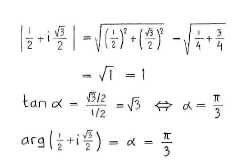Solution 3.3:1b
From Förberedande kurs i matematik 2
(Difference between revisions)
(Ny sida: {{NAVCONTENT_START}} <center> Bild:3_3_1b.gif </center> {{NAVCONTENT_STOP}}) |
m |
||
| (4 intermediate revisions not shown.) | |||
| Line 1: | Line 1: | ||
| - | {{ | + | First, we write the number <math>\frac{1}{2}+i\frac{\sqrt{3}}{2}</math> in polar form. |
| - | <center> [[ | + | |
| - | {{ | + | <center>[[Image:3_3_1_b.gif]] [[Image:3_3_1_b_text.gif]]</center> |
| + | |||
| + | Thus, | ||
| + | |||
| + | {{Displayed math||<math>\frac{1}{2}+i\frac{\sqrt{3}}{2} = 1\cdot \Bigl(\cos\frac{\pi}{3} + i\sin\frac{\pi}{3}\Bigr)</math>}} | ||
| + | |||
| + | and de Moivre's formula gives | ||
| + | |||
| + | {{Displayed math||<math>\begin{align} | ||
| + | \Bigl(\frac{1}{2}+i\frac{\sqrt{3}}{2}\Bigr)^{12} | ||
| + | &= 1^{12}\cdot\Bigl(\cos\Bigl(12\cdot\frac{\pi}{3}\Bigr) + i\sin\Bigl(12\cdot\frac{\pi}{3}\Bigr)\Bigr)\\[5pt] | ||
| + | &= 1\cdot (\cos 4\pi + i\sin 4\pi)\\[5pt] | ||
| + | &= 1\cdot (1+i\cdot 0)\\[5pt] | ||
| + | &= 1\,\textrm{.} | ||
| + | \end{align}</math>}} | ||
Current revision
First, we write the number \displaystyle \frac{1}{2}+i\frac{\sqrt{3}}{2} in polar form.


Thus,
| \displaystyle \frac{1}{2}+i\frac{\sqrt{3}}{2} = 1\cdot \Bigl(\cos\frac{\pi}{3} + i\sin\frac{\pi}{3}\Bigr) |
and de Moivre's formula gives
| \displaystyle \begin{align}
\Bigl(\frac{1}{2}+i\frac{\sqrt{3}}{2}\Bigr)^{12} &= 1^{12}\cdot\Bigl(\cos\Bigl(12\cdot\frac{\pi}{3}\Bigr) + i\sin\Bigl(12\cdot\frac{\pi}{3}\Bigr)\Bigr)\\[5pt] &= 1\cdot (\cos 4\pi + i\sin 4\pi)\\[5pt] &= 1\cdot (1+i\cdot 0)\\[5pt] &= 1\,\textrm{.} \end{align} |
